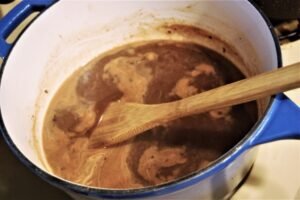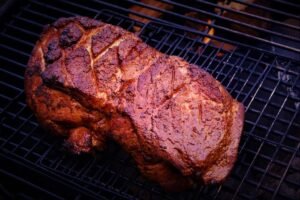Several factors differentiate barbeque in
the South from other regions in the country. Southerners usually barbeque their
meat low and slow over a smoky wood fire. Cooking is often an all-day affair
during which they socialize with their friends and family. For most folks
in the South (excluding Texas) barbeque means pork. In the Carolinas, pulled
pork is a favorite. Often it is served with a thin vinegar and pepper sauce or
a mustard sauce.
Roasted
chicken is also popular in the Southern states, particularly in Alabama. There chicken
is dipped in a mayonnaise and vinegar sauce. If you haven’t tried this or other
unique sauces from this region of the country, you are missing out on a special
culinary experience.
Jim’s
Pulled Pork Pepper Sauce
My
pulled pork pepper sauce is based on the vinegar and pepper sauce that
originated along the Eastern coast of the Carolinas. Some believe that Scottish
settlers in Williamsburg County, South Carolina first created the sauce. Others
credit African slaves with making a sauce using vinegar and peppers.
Ingredients
1
cup apple cider vinegar
1
cup white distilled vinegar
½
cup KC Masterpiece BBQ sauce
1
Tablespoon brown sugar
1
teaspoon cayenne pepper
1
Tablespoon hot sauce
½
teaspoon red pepper flakes
1
teaspoon salt
1
teaspoon black pepper
2
teaspoons garlic powder
2
teaspoons onion powder
Juice
of half of a lemon
Directions
Mix
the ingredients and heat until it comes to a boil. Reduce to a simmer for 10
minutes. As you are simmering the sauce, taste test it. Remember: TEST, DON’T
GUESS. If the pepper sauce needs a little more heat to suit your taste, gradually
add more cayenne pepper.
using cast iron, always heat on low or medium, never any higher.
This
is a great sauce for basting ribs or a pork butt. It is also great as a
condiment when making a pulled pork sandwich.
The
next time that you make pulled pork, smoke the pork butt until it reaches an
internal temperature of 165⁰ F. When first smoking a pork butt, the fat cap should be on the top. Smoking the meat should take about 4 hours. This is not the end of the cooking process. You must continue to roast the meat until the connective tissue breaks down.
To do this the accepted practice is to wrap the meat in foil. An alternative method is to put the
meat in a disposable aluminum pan with the fat cap facing down. Before transferring the meat, add a stick of butter, brown sugar, honey and a cup of my pepper sauce to the bottom of the pan.
By
covering the pan with one or two layers of heavy-duty aluminum foil, you are in
essence steaming the meat until it reaches an internal temperature of 205⁰ F.
This high temperature is needed to break down the meat’s connective tissue.
After covering the pork butt, it generally takes about 2 additional hours of
cooking time for the meat to come to temp.
CAUTION: The
foil traps the steam, be careful as you remove it. To avoid burning yourself,
you can check the temperature by poking the probe of your digital thermometer
right through the foil.
After
the meat has come to temp, allow it to rest for 30 minutes. Shred the pork.
Then add any additional pepper sauce little by little, tasting as you go along,
if the meat looks a little dry.
South Carolina Mustard Sauce
In
central South Carolina, the folks prefer a mustard sauce to either
vinegar-based sauces or sweet tomato sauces. Many believe that German
immigrants originally created this sauce in the early eighteenth
century. Some dispute this claim as more local myth than historical fact. What
really matters is that this sauce tastes great.
Because
South Carolina mustard sauce is based on yellow mustard, you might assume that
its color is yellow and tastes like the mustard that you would get at the
ballpark. You know what they say about assuming.
In
fact, this mustard sauce has a golden color and is sweet and tangy. Its unique
flavor results from several ingredients including honey, brown sugar and apple
cider vinegar. While this sauce tastes
great on pulled pork, you can also use it as a dipping sauce or as a condiment
on brats, ribs and hamburgers.
INGREDIENTS
¾
cup yellow mustard
¼
cup stone-ground mustard
¼
cup apple cider vinegar
¼
cup honey
¼
cup brown sugar
2
Tablespoons KC Masterpiece BBQ sauce
2
Tablespoons hot sauce
½ Tablespoon smoked
paprika
½
Tablespoon Worcestershire sauce
½
teaspoon garlic granules
½
teaspoon onion powder
½ teaspoon salt
¼
teaspoon black pepper
DIRECTIONS
Whisk
to blend the ingredients. Heat in a non-reactive pan on low. Simmer for 10 to
15 minutes. Stir occasionally. Taste test the mixture. Remember: Test, Don’t
Guess. Adjust the seasoning of the sauce to your liking. Allow the mixture
to cool. Pour into a Mason jar and refrigerate.
Alabama White Sauce
You surely have used barbeque sauces that
were red and some that were brown. Unless you are from Alabama, you may never
have tried a BBQ sauce that was white. Frankly, a white sauce on BBQ neither
looks nor sounds appetizing. If that’s how you feel, perhaps it’s time to
experience one of those dreaded paradigm shifts. Without a doubt Alabama white sauce is
something totally different yet totally delicious.
Nearly 100 years ago BBQ pioneer Big Bob
Gibson created his white sauce for grilled or smoked chicken. Gibson combined a
North Carolina vinegar sauce with mayonnaise. Mayonnaise-based sauces have
always been popular in the Deep South. (See my article on mayonnaise-based sauces, many of which
originated in the Southern states, including Comeback Sauce and Remoulade
Sauce.)
The purpose of the Gibson’s Alabama white
sauce was to prevent the chicken from drying out. In Northern Alabama, after
the chicken is fully cooked, the folks dunk a whole barbequed bird in this
sauce. If that’s not enough sauce for you, Alabama restaurants often provide
this thin white sauce in squeeze bottles or jars as a condiment.
The next time you grill chicken give this
sauce a try. As you can see from the recipe below, it is easy to make. Alabama
white sauce is also a great sauce for pulled pork or as a dipping sauce for
chicken wings. Plus try drizzling it on sandwiches and over potato chips or
fries.
Ingredients
2 cups mayonnaise
1 cup distilled white vinegar
½ cup apple juice
2 teaspoons prepared horseradish
2 teaspoons ground black pepper
2 teaspoons lemon juice
1 teaspoon salt
½ teaspoon cayenne
pepper
½ teaspoon hot sauce
½ teaspoon garlic
powder
½ teaspoon onion
powder
½ Tablespoon
Worcestershire sauce
1 Tablespoon sugar
Directions
Whisk the ingredients together. Taste the sauce
and adjust the seasoning as needed. Pour the sauce in a Mason jar and
refrigerate it. It will stay good for up to two weeks.
Try these other Signpost Recipes
The Best Bacon Wrapped Jalapeno Poppers
The Best Beef and Cheese Enchiladas
© 2022 Jim Hingst, All Rights Reserved





